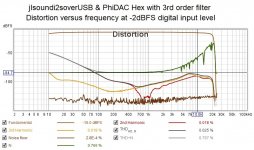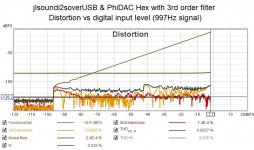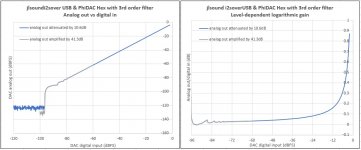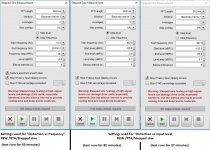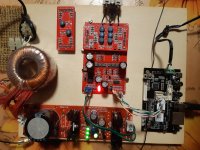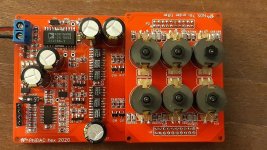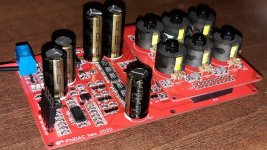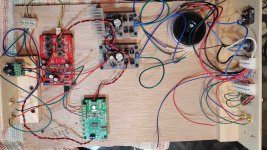You are welcome TNT.
Now the same tests on the DAC with the 3rd order filter installed.
(again, spikes at 1st attachment are measurement glitches, there is no real distortion peaking)
George
Now the same tests on the DAC with the 3rd order filter installed.
(again, spikes at 1st attachment are measurement glitches, there is no real distortion peaking)
George
Attachments
Pleased to hear that Guglielmo - do you have any comments about how the different filters sound ? Also have you tried your 5th order filter in your other DAC yet?
One of two.
Which is better? Mainly sound quality.
There are a couple using CM6631A that look suitable to me. I prefer the CM6631A to an XMOS solution - for PhiDAC hex we don't need any sample rates beyond 192k nor DSD.
???CM6631A USB?I2S????/USB????/????/XMOS DAC-???
????CM6631A????I2S SPDIF??24Bit 192K 384K ASIO-???
If you have your own preference then sure, we'll order the one you want to accompany your PhiDAC hex order.
Which is better? Mainly sound quality.
The module PhiDAC works, all voltages are ok. I'm waiting for the input module to be delivered. Then I will write how I like the sound.

Last edited:
Please inspire which amplifier is suitable for PhiDAC for 32ohm headphones (Meze 99 Classics) I also have a Sennheiser HD 800 and I have built an amplifier with lamps for them. Thank you for your response.
TDA8932 is quite suitable for driving 32ohm headphones. You can buy boards with that chip on quite cheaply, or you could buy my design and modify it for headphones (as its bridged and you'd want single-ended).
This one is my TDA8932 amp : Transformer-fed TDA8932 25W/8R mono amp kits
Its designed for speakers but I've prototyped it with headphones (HD6XX, 300 ohm) and it sounds great with them. If you buy a stereo pair you need to take the output from only one phase as the amp's bridged. This means take the +ve output and feed that through a cap to your headphone +ve. The headphone's GND goes to power supply GND. The cap should be a 2200uF electrolytic 25V.
Its designed for speakers but I've prototyped it with headphones (HD6XX, 300 ohm) and it sounds great with them. If you buy a stereo pair you need to take the output from only one phase as the amp's bridged. This means take the +ve output and feed that through a cap to your headphone +ve. The headphone's GND goes to power supply GND. The cap should be a 2200uF electrolytic 25V.
Another Phidac sings. I threw a bunch of spare parts that I had lying around on a board to test the DAC. I used an older spdif receiver from Twisted Pear to feed the dac. I needed to select a 16 bit word length by setting AIDCONF0 and AIFCONF1 to (-) on the tristate switches to get it to work with this dac. I only had to chance to listen to it briefly on my garage system but it sounds very promising. I did a very short comparison to a modified Chinese 9038Q2M DAC that I had hooked up out there (you know the one everone was modding last year). The two dacs do sound different from each other. The 9038Q2M sounds warmer/thicker, seems not quite as detailed, probably due to the higher noise floor. Musical notes on the Phidac like piano and guitar have more prolonged decay, sound more realistic, the overall impression is it has greater detail. The highs aren't rolled off like in some NOS dacs that I've tried, sounds much better than a budget NOS TDA1387 board that I had tried out. My next step is to put it into a decent case with decent power supplies and USB input to try it out in my good systems.
Attachments
Existing customers of PhiDAC hex don't need to buy a whole new DAC in order to upgrade. Seeing as the plug-in filters are not changing, the one(s) you have already will be good for PhiDeca DAC too. So then only a new baseboard will be required if you want to move up to the next generation DAC.
You should just have launched a fully-made product via kickstarter. ...such a small fraction of enthusiasts will go near soldering.
I see your signature regarding ASR, after testing their so-called top DACs/amps I came back here after buying a cheap as chips aliX 1387 DAC -what have I been missing..it completely hoses the DS DACs..so liquid and analogue and I know its not even a corrected design like the above DAC you have.
I see your signature regarding ASR, after testing their so-called top DACs/amps I came back here after buying a cheap as chips aliX 1387 DAC -what have I been missing..it completely hoses the DS DACs..so liquid and analogue and I know its not even a corrected design like the above DAC you have.
For the time being I'm content to address that small fraction of enthusiasts. The design of the filters isn't cut out for mass production. Perhaps in future I'll come up with a passive filter implementation that can be fairly easily replicated.
Jaxhouse, I currently have a SMSL Sanskrit MkII here on loan from another DIYA member. An example of a modern DAC which ticks all the boxes for objective performance with noise and distortion measurements and thus something that many would expect to sound phenomenal according to its ASR review. Yes, I tried it with multiple transports, and upsampling up to 768KHz. And yet...TDA1387 even in a basic implementation, absolutely stomps it in terms of subjective sound quality.
- Home
- Vendor's Bazaar
- PhiDAC hex kits with pre-built filters
